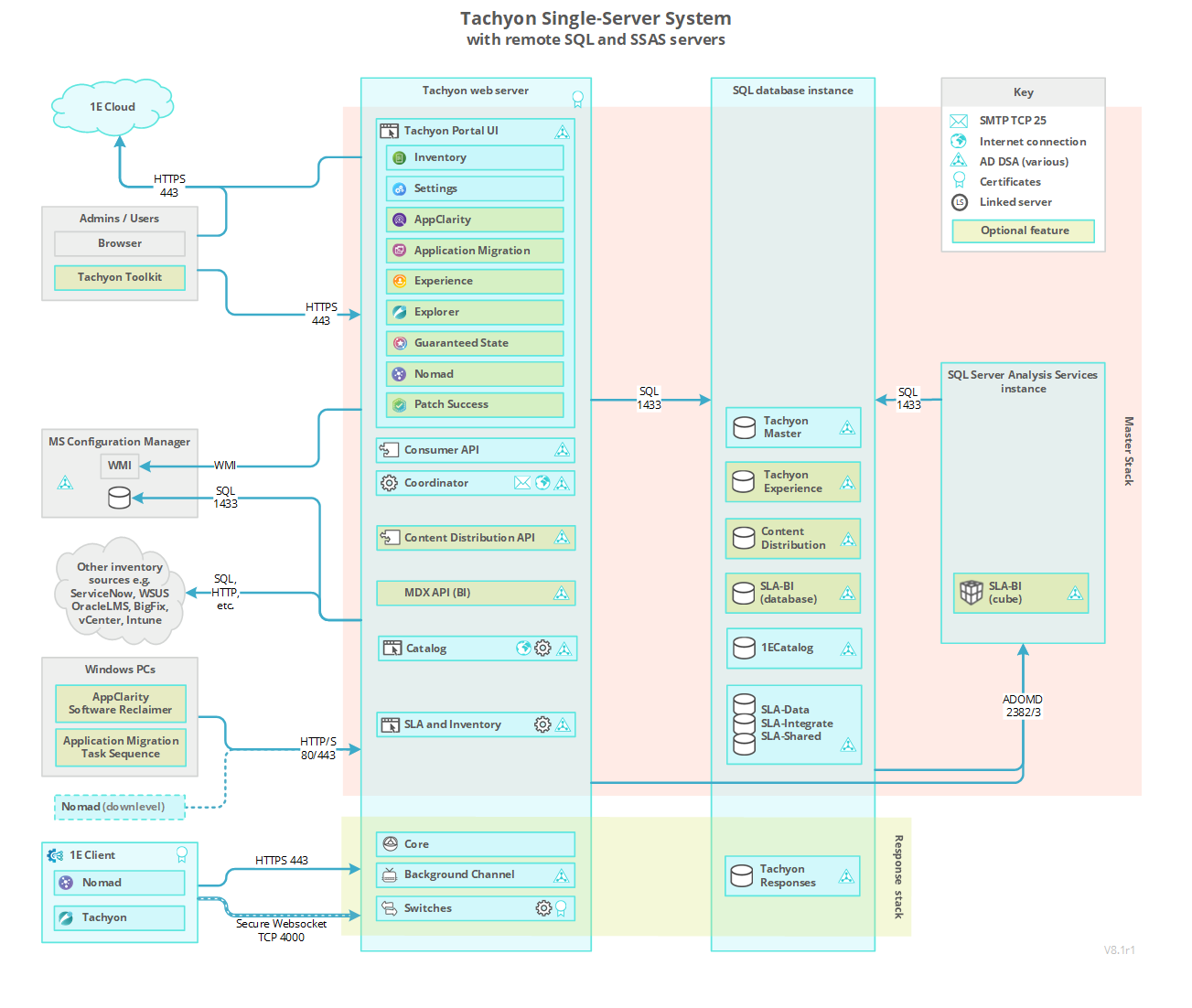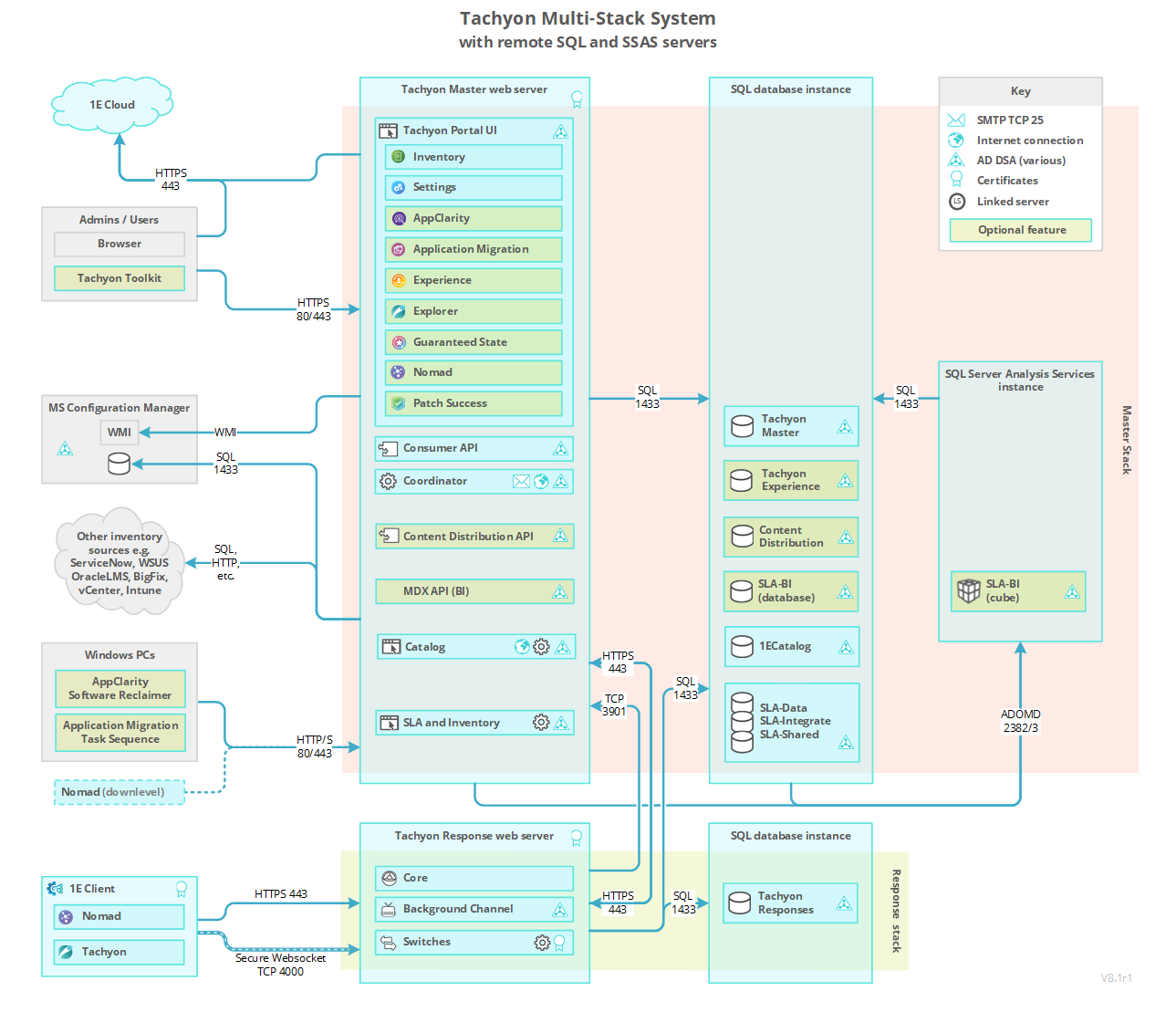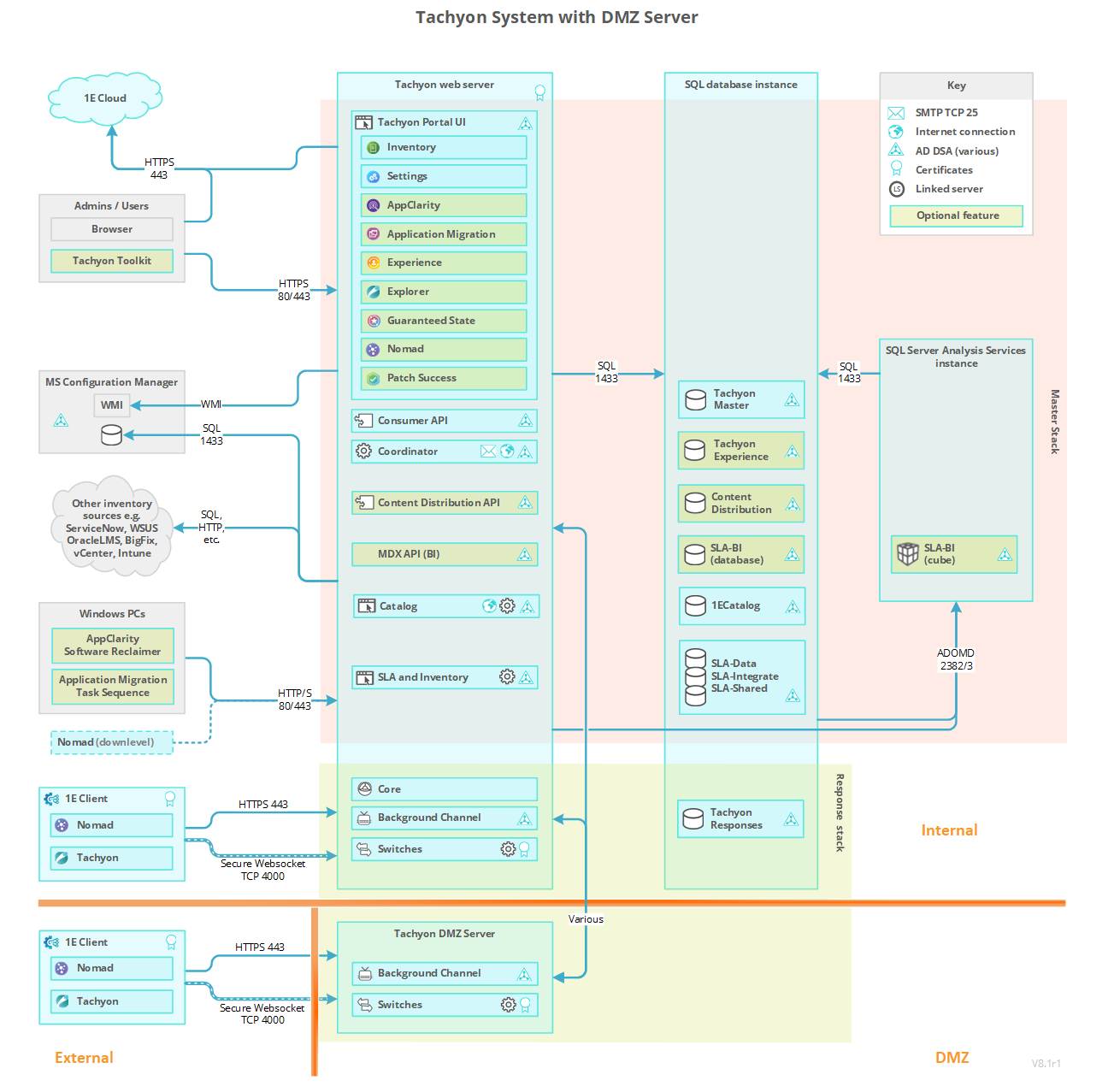Tachyon Architecture
A description of Tachyon Stacks and their Tachyon components, the Tachyon clients, and how they connect to provide Tachyon features.
Tachyon deployment architecture
At the top-most level, Tachyon architecture consists of Tachyon Server components, grouped into Stacks, and clients that are deployed onto the devices that you want to manage.
Tachyon Server Stacks
Every Tachyon system has a single Master Stack, which provides web services for Tachyon applications. Master Stack components are typically all installed on a single Master Server.
Tachyon real-time features require Response Stacks, which are made up of one or more Response Servers. A DMZ Server is an example of a Response Server. Each Response Stack has at least one Background Channel for sharing resources and a single Core component that supports an associated set of up to five Switches. Switches are the primary mechanism for rapidly requesting and retrieving responses from the 1E Client. As each Switch can handle up to 50,000 devices there is a limit of 250,000 devices per Response Stack. Higher numbers can be achieved if you contact 1E for guidance. Switches may be local or remote to the other components in the Response Stack.
Databases for Tachyon, 1E Catalog, Nomad, Experience, SLA and BI, are installed on SQL Server database instance(s) that may also be local or remote to their respective Master and Response servers. It is also possible for multiple Response Stacks to share the same Responses database. The Cube used by Patch Success (SLA-BI) is installed on a local or remote SQL Server Analysis Services (SSAS) instance.
Please refer to the:
Architectural requirements section for guidance on which architecture to choose
Communication Ports reference page for connection details between components and ports necessary for firewalls.
Tachyon Single-Server system
In the most basic setup, there is a single server that hosts both a Master Stack and a Response Stack and this can be deployed by selecting the default settings in Tachyon Setup.
The following table shows the Tachyon platform components, including Tachyon Master and Response Stacks, and also shows the DMZ Server discussed in Tachyon architecture for Internet-facing devices.
Subsystem | Component | Web application | Master Stack | Response Stack | DMZ Server |
|---|---|---|---|---|---|
Master Server | Tachyon Portal UI and applications | Tachyon | 1 | ||
Consumer API | Consumer | 1 | |||
Coordinator service | 1 | ||||
Tachyon Master database | 1 (optionally Remote) | ||||
Experience | Experience API | Experience | 1 | ||
Experience database | 1 (optionally Remote) | ||||
Nomad | Nomad API | Nomad | 1 (optional) | ||
Nomad database | 1 (optionally Remote) | ||||
1E Catalog | 1E Catalog UI | CatalogWeb | 1 | ||
1E Catalog API | CatalogWeb | ||||
1E Catalog Update Service | |||||
1E Catalog database | 1 (optionally Remote) | ||||
SLA and Inventory | SLA Platform UI and SLA applications | Platform | 1 | ||
SLA Admin | Admin | 1 | |||
SLA Engine | 1 | ||||
SLA Integrate services:
| 1 | ||||
SLA Operations Provider API | CoreExternal | 1 | |||
SLA databases (Data, Integrate, Shared) | 1 (optionally remote) | ||||
SLA Business Intelligence (BI) (for Patch Success) | MDX API (BI) | 1 | |||
SLA-BI database | 1 (optionally Remote) | ||||
SLA-BI cube (requires SSAS) | 1 (optionally Remote) | ||||
Response Server | Core | Core | 1 | ||
Background Channel | Background | 1 | 1 | ||
Switch(es) (also includes a single Switch Host service) | up to 5 (optionally Remote) | up to 5 | |||
Tachyon Responses database | 1 (optionally Remote) |
The picture shows a Tachyon Single-Server System with databases optionally installed locally or on remote SQL Server instance(s). Components colored green are optional in a Tachyon system.
The Response Stack can be installed on the same server as the Master Stack, and on remote servers.
The DMZ Server has only the Tachyon client-facing components of the Response Stack: the Background Channel and Switches.

Applications and Tools
Tachyon applications and tools are consumers, and all consumers connect to the Tachyon Consumer API.
The following consumer applications run on the Tachyon platform and are installed using Tachyon Setup. Please also refer to the License requirements page.
Applications are categorized as follows:
Configuration - applications required to configure the Tachyon platform and required by all other applications
Client - applications that communicate with devices in real-time
Inventory – applications that use inventory features.
Applications that are included in the Tachyon Platform license
Application | Purpose | Type |
|---|---|---|
View and export inventory, and manage associations. It uses the SLA databases. | Inventory, configuration | |
Configure and monitor platform features. It uses the Tachyon Master database. | Configuration | |
Ensure endpoint compliance to enterprise IT policies. It uses the Tachyon Master and Responses database. | Client | |
Investigate, remediate issues and manage operations across all your endpoints in real-time. It uses the Nomad Master and Responses database. | Client |
Applications that require a license
Application | Purpose | Type |
|---|---|---|
Manage software license compliance, License Demand Calculations, license entitlements, and for reclaiming unused software. It uses the SLA databases. | Inventory | |
Intelligently automate the migration of applications during a Configuration Manager OS deployment. It uses the SLA databases. | Inventory | |
Manage content distribution across your organization using a centralized dashboard. It uses the Content Distribution database. 1E Client requires Tachyon and Content Distribution features to be enabled on all clients. Content Distribution replaces the Nomad features of ActiveEfficiency Server, which is deprecated. Legacy Nomad clients continue to be supported by direct communication with the Content Distribution API, whereas Nomad 8.x clients communicate with the Content Distribution API via the proxy feature on Response Servers. Tachyon Setup Setup is used to install Content Distribution, and the Nomad app, and no longer installs ActiveEfficiency. Nomad uses Content Distribution for the following features:
| Client | |
Reports on and ensures successful patching of your enterprise. It uses the SLA and BI databases. Tachyon Setup indstalls SLA Business Intelligence, which requires SQL Server Analysis Server. Patch Success also uses Inventory connectors to get meta-data for patches from whichever of the following that you use to approve patches:
| Inventory | |
Measure performance, stability and responsiveness for applications and devices to assess user experience across your enterprise. It uses the Tachyon Master and Tachyon Experience databases. | Client |
The following types of application require 1E Client (with Tachyon features enabled) to be deployed to all in-scope devices.
All Client applications
Inventory applications if you intend using the Tachyon connector to populate your inventory.
The AI Powered Auto-curation feature is optionally used by Inventory applications to provide automatic curation of new products. This avoids having to manually add products to the 1E Catalog, or wait for it be updated. This optional feature requires additional memory on the Tachyon Server (Master Stack). Please refer to AI Powered Auto-curation: Memory requirements for details.
Some benefits of using AI Powered Auto-curation are that you can:
Achieve significantly more normalized software from the first sync
Reduce the manual effort required to normalize software
Get an expanded SAM offering as more data is available for AppClarity
Get additional coverage for Application Migration
Identify more software to review for security threats.
Tachyon Tools
The following are tools included in Tachyon platform. These tools are not installed using Tachyon Setup. They have either their own installers or are included in download zips.
Tachyon ConfigMgr UI Extensions - installed as part of the Tachyon Toolkit, this is a right-click extension for the Configuration Manager console that provides the option to browse and run an instruction on devices in a specified Collection, refer to Preparing for the Tachyon extensions for the Configuration Manager Console. for details.
Tachyon Run Instruction command-line tool - installed as part of the Tachyon Toolkit, it is used for sending instructions to the Tachyon server from a script or from a command prompt.
Tachyon Product Pack Deployment Tool - included in the Tachyon platform zip ProductPacks folder.
TIMS - used for the development of instructions using the Tachyon SDK, refer to About TIMS for details.
A typical Tachyon license allows the use of all these tools.
Tachyon Multi-Stack system
The picture shows a Tachyon Multi-Stack System. Here the Tachyon Master Stack communicates with one or more Tachyon Response Stacks. A local Response Stack is not mandatory. Components colored green are optional in a Tachyon system.
As with a single-server system, the databases are optionally installed locally or on remote SQL Server instances(s).

Tachyon components
Let's take a look at each of the Tachyon components in slightly more detail.
Component | Description | ||||
|---|---|---|---|---|---|
IIS Components | The following components are IIS Web Applications that reside on a single-server. Other configurations - such as Response Stack and DMZ Server - have a subset of these. Under the Tachyon website:
| ||||
Core | The Core is a Tachyon Response Stack component which provides internal API and data processing. Core does the following:
| ||||
Background Channel | The Background Channel is a Tachyon Response Stack component which provides a means for the Tachyon clients to retrieve large data items from Tachyon without loading the Tachyon Switch:
| ||||
Switch | The Switch is a Tachyon Response Stack component which provides the following:
The Switch Host service is responsible for starting local Switches. | ||||
Tachyon Portal UI | Tachyon users browse to the portal to access Tachyon applications. Applications that are Tachyon built-in applications:
Applications that are optional:
| ||||
Tachyon Consumer API | The Tachyon Consumer API provides the following:
| ||||
Tachyon Coordinator | The Coordinator service is the coordinating service used by Tachyon components. It has two modules, Workflow and Instrumentation. The Workflow module provides the following:
The Instrumentation module processes instrumentation data from the following components:
And responds to requests for instrumentation data from the Consumer API. Supports the two-factor authentication feature, with email. | ||||
Nomad | Content Distribution replaces the related features of ActiveEfficiency Server, which is deprecated. Legacy clients continue to be supported by direct communication with the Content Distribution API, whereas Nomad 8.x clients communicate with the Content Distribution API via the proxy feature on Response Servers. Tachyon Setup is used to install Content Distribution and the Nomad app, and no longer installs ActiveEfficiency. Nomad includes the following features:
| ||||
1E Catalog UI | The website is used to view and interact with the 1E Catalog. Tachyon Setup supports the installation of 1E Catalog on the Tachyon Master Stack server. For customers that want to continue using an existing installation of 1E Catalog 2.0 then Tachyon Setup supports using a remote Catalog server as a custom setup option. Please contact 1E for details on how to use custom setup options. | ||||
Catalog Update Service | Service is used to connect to the 1E Cloud Catalog in order to download the latest catalog entries. | ||||
Catalog API | Consumer API is used to manage and update the 1E Catalog. | ||||
SLA Admin | Internal API used to manage SLA components. | ||||
SLA Platform UI | The website is used to view and interact with the Inventory. | ||||
SLA Engine | The Engine service is the coordinating service used by SLA components. This includes processing of Management Groups. | ||||
SLA Integrate Services | The SLA Integrate Agent sevice performs Connector functions by connecting to data sources and importing data into repositories. The SLA Integrate Manager service manages Agent operations including repository action schedules. | ||||
SLA Inventory | The inventory repositories. Each instance of a repository is stored in SLA-Data database, and is based on a template defined in the SLA-Data database. | ||||
SLA Operations Provider API | Consumer API and functions used by SLA clients, including Application Migration task sequence steps and AppClarity Software Reclaimer. | ||||
MDX (BI) | Internal API used by Patch Success application. Business Intelligence is an optional component installed by Tachyon Setup on the Master Stack, and requires SQL Server Analysis Services (SSAS). Business Intelligence is a prerequisite for the Patch Success application to support efficient presentation of visualizations on a large scale. | ||||
Consumer applications | The following Consumer applications are licensed:
The following Consumer applications are included with Tachyon platform:
Other consumers are Tachyon Configuration Manager Console extensions and other toolkit features. | ||||
SQL Server (Database Engine and Analysis Services) | Tachyon has two databases:
Experience has one database:
1E Catalog has one database:
SLA has three databases:
SLA BI has two databases:
Nomad has one database:
| ||||
1E Client | 1E Client includes clients for Tachyon, Nomad, PXE Everywhere Agent, Shopping/WSA, and WakeUp. All the above are supported on Windows devices, client features (excluding Experience and User Interaction) are also available on non-Windows devices. Tachyon clients communicate with the Tachyon Switches and the Background Channel to provide responses to instructions (questions and actions) and subscribe to policy events for Experience and Guaranteed State. Nomad clients use Tachyon Switches and the Background Channel as a proxy for communicating with the Content Distribution. |
Tachyon architecture for Internet-facing devices
Enabling Tachyon to support devices that are external to your company network is done by slightly extending the default single-server architecture.
To enable external Tachyon client devices to interact with Tachyon, the DMZ requires at least one Background Channel and at least one Switch.
The Responses Stack handles communications between Master Stack and the platform clients. The Background Channel and Switch components handle the direct communication with the platform clients, the Core processes the information in both directions between the Master Stack and the Switches.
First, you need a working Tachyon system on the internal network, with a Response Stack that will provide the Core for the DMZ Server. The picture shows a Response Stack and Master Stack on the same server, located on the internal network. This serves clients when they are connected to the internal network.
Then configure the internal firewall to allow two-way communication between each of the following:
The Core on the Internal Response Stack and the Switch(es) in the DMZ
The Coordinator on the internal Response Stack and the Switch(es) in the DMZ
The Consumer API on the internal Master Stack and the Background Channel in the DMZ.
Configure the external firewall to allow incoming connections for:
The external platform clients and the Background Channel in the DMZ
The external platform clients and the Switch(es) in the DMZ.
After you have provisioned a server in the DMZ, you need to make the following changes to the existing Tachyon system:
Run Tachyon Setup on the Tachyon Response Stack to tell it about the DMZ Server, which will do the following:
Prepare the Master database with relevant details of the DMZ Background Channel and Switch(es)
Raise the security level of the Core and Switch communications
Produce a configuration file for the DMZ Server.
Run Tachyon Setup on the DMZ Server using the pre-prepared configuration file, to complete the installation of DMZ Background Channel and Switch(es).
Detailed steps for the above process can be found on the Implementing a Tachyon DMZ Server page.
Tip
The DMZ picture shows a dual firewall design, but a single firewall is also supported.
In the picture, components colored green are optional in a Tachyon system.
